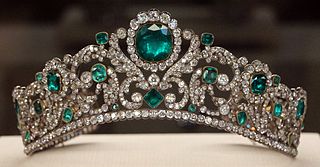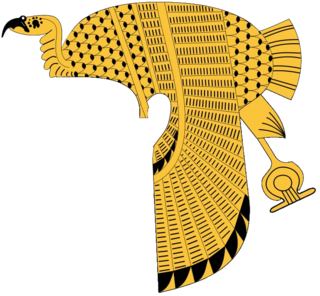
A perak is a headdress typically worn by the old aristocracy in the Himalayan Ladakh region of Asia. It is composed of a strap of leather studded with semi-precious stones, such as lapis lazuli and turquoise.

A perak is a headdress typically worn by the old aristocracy in the Himalayan Ladakh region of Asia. It is composed of a strap of leather studded with semi-precious stones, such as lapis lazuli and turquoise.
The perak is a symbol among the Ladakh of the rank and economic status of the woman wearing it. [1] Traditionally, the number of front-to-back rows of turquoise signified the status of the wearer: nine rows for the queen of Leh (the Ladakh capital), seven rows for the more modern aristocracy, five for the marvels, and three for the lower ranks.
The jewels themselves are representative of the Ladakh deities, protecting and guiding the wearer through the dangerous human world.

A tiara is a jeweled head ornament. Its origins date back to ancient Iran, which was then adapted by Greco-Romans. In the late 18th century, the tiara came into fashion in Europe as a prestigious piece of jewelry to be worn by women at formal occasions. The basic shape of the modern tiara is a semi-circle, usually made of silver, gold or platinum and richly decorated with precious stones, pearls or cameos.

A turban is a type of headwear based on cloth winding. Featuring many variations, it is worn as customary headwear by people of various cultures. Communities with prominent turban-wearing traditions can be found in the Indian subcontinent, Southeast Asia, the Middle East, the Balkans, the Caucasus, Central Asia, North Africa, West Africa, East Africa, and amongst some Turkic peoples in Russia.

Bunad is a Norwegian umbrella term. In a broader sense, the term encompasses household, householding equipment, and livestock as well as both traditional rural clothes and modern 20th-century folk costumes. In its narrowest sense, the word bunad refers only to clothes designed in the early 20th century that are loosely based on traditional costumes.

A homburg is a semi-formal hat of fur felt, characterized by a single dent running down the centre of the crown, a wide silk grosgrain hatband ribbon, a flat brim shaped in a "pencil curl", and a ribbon-bound trim about the edge of the brim. It is traditionally offered in black or grey.

Ottoman clothing or Ottoman fashion is the style and design of clothing worn during the Ottoman Empire.

War bonnets are feathered headgear traditionally worn by male leaders of the American Plains Indians Nations who have earned a place of great respect in their tribe. Originally they were sometimes worn into battle, but they are now primarily used for ceremonial occasions. In the Native American and First Nations communities that traditionally have these items of regalia, they are seen as items of great spiritual and political importance, only to be worn by those who have earned the right and honour through formal recognition by their people.

The hennin was a headdress in the shape of a cone, steeple, or truncated cone worn in the Late Middle Ages by European women of the nobility. They were most common in Burgundy and France, but also elsewhere, especially at the English courts, and in Northern Europe, Hungary and Poland. They were little seen in Italy. It is unclear what styles the word hennin described at the time, though it is recorded as being used in French areas in 1428, probably before the conical style appeared. The word does not appear in English until the 19th century. The term is therefore used by some writers on costume for other female head-dresses of the period.

The kokoshnik is a traditional Russian headdress worn by women and girls to accompany the sarafan. The kokoshnik tradition has existed since the 10th century in the city of Veliky Novgorod. It spread primarily in the northern regions of Russia and was very popular from 16th to 19th centuries. It is still to this day an important feature of Russian dance ensembles and folk culture and inspired the Kokoshnik style of architecture.

Fashion in 15th-century Europe was characterized by a surge of experimentation and regional variety, from the voluminous robes called houppelandes with their sweeping floor-length sleeves to the revealing giornea of Renaissance Italy. Hats, hoods, and other headdresses assumed increasing importance, and were draped, jeweled, and feathered.

Aztec clothing was worn by the Aztec people and varied according to aspects such as social standing and gender. The garments worn by Aztecs were also worn by other pre-Columbian peoples of central Mexico who shared similar cultural characteristics. The strict sumptuary laws in Aztec society dictated the type of fiber, ornamentation, and manner of wear of Aztec clothing. Clothing and cloth were immensely significant in the culture.

Headgear, headwear, or headdress is any element of clothing which is worn on one's head, including hats, helmets, turbans and many other types. Headgear is worn for many purposes, including protection against the elements, decoration, or for religious or cultural reasons, including social conventions.

The poffer, toer or North Brabantian hat is a traditional female folk headdress of North Brabant, most famous of the Meierij of 's-Hertogenbosch and of northern Limburg, Netherlands. The poffer was worn only by married women. It was fashionable between the 1860s and the 1920s. In contrast to Zeeland and the more northern parts of the Netherlands, in North Brabant and Limburg there was never any distinctive folkloric costume worn by either men or women, making the poffer the only folkloric garment in this part of the Netherlands.

Pheran or Phiran is the traditional outfit for both males and females in Kashmir.

History of clothing in the Indian subcontinent can be traced to the Indus Valley civilization or earlier. Indians have mainly worn clothing made up of locally grown cotton. India was one of the first places where cotton was cultivated and used even as early as 2500 BCE during the Harappan era. The remnants of the ancient Indian clothing can be found in the figurines discovered from the sites near the Indus Valley civilisation, the rock-cut sculptures, the cave paintings, and human art forms found in temples and monuments. These scriptures view the figures of human wearing clothes which can be wrapped around the body. Taking the instances of the sari to that of turban and the dhoti, the traditional Indian wears were mostly tied around the body in various ways.

The keffiyeh or kufiyyeh, also known in Arabic as a hattah, is a traditional headdress worn by men from parts of the Middle East. It is fashioned from a square scarf, and is usually made of cotton. The keffiyeh is commonly found in arid regions, as it provides protection from sunburn, dust, and sand. The regional variations are called ghutrah and shemagh. A head cord, agal, is often used by Arabs to keep the ghutrah in place.

The Balzo was a headdress worn by noblewomen of Italy in the 1530s. It was donut-shaped but appeared turban-like from the front, though it was generally worn further back from the forehead exposing the hair, unlike a period turban.

The Vulture crown was an ancient Egyptian crown worn by Great Royal Wives and female pharaohs. It was depicted as a headdress in the shape of a vulture draped over the head, with its wings hanging down on the sides. It was a symbol of protection associated with the vulture goddess Nekhbet, who often wore this crown when depicted in a human form. These crowns were frequently worn by the Great Royal Wife, high ranking priestesses, and female pharaohs. These crowns were also sometimes equipped with the Uraeus to symbolize Wadjet, representing both Upper (Nekhbet) and Lower Egypt (Wadjet).

Kimeshek or Elechek is a traditional headgear of married women with children in Kazakhstan, Karakalpakstan (Uzbekistan) and Kyrgyzstan. Kimeshek is also worn by Central Asian Jewish women. Uzbek and Tajik women wear a similar headdress called lachak. Kimeshek is made of white cloth, and the edge is full of patterns. Kimeshek might have different designs and colors based on the wearer's social status, age, and family.

The gargush is a traditional Yemenite Jewish headdress, resembling a hood that is thought to have originated in the Sanaʿite community. It's worn as a traditional headpiece among Israeli Jews in the modern era.

Liangbatou or erbatou is a hairstyle/headdress worn by Manchu women. It is a tall headdress that features two handfuls of hair, parted to each side of the head, sometimes with the addition of wire frames, extensions and ornamentation.